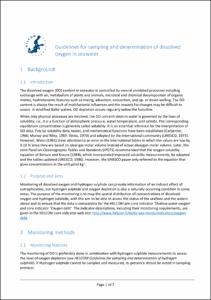| dc.coverage.spatial | Baltic Sea | en_US |
| dc.date.accessioned | 2022-07-13T19:50:01Z | |
| dc.date.available | 2022-07-13T19:50:01Z | |
| dc.date.issued | 2018 | |
| dc.identifier.citation | HELCOM (2018) Guidelines for sampling and determination of dissolved oxygen in seawater. Helsinki, Finland, HELCOM, 7pp. DOI: http://dx.doi.org/10.25607/OBP-1804 | en_US |
| dc.identifier.uri | https://repository.oceanbestpractices.org/handle/11329/2009 | |
| dc.identifier.uri | http://dx.doi.org/10.25607/OBP-1804 | |
| dc.description.abstract | The dissolved oxygen (DO) content in seawater is controlled by several unrelated processes including exchange with air, metabolism of plants and animals, microbial and chemical decomposition of organic matter, hydrodynamic features such as mixing, advection, convection, and up- or down-welling. The DO content is always the result of multifactorial influences and the reasons for changes may be difficult to assess. In stratified Baltic waters, DO depletion occurs regularly below the halocline.
When only physical processes are involved, the DO concentration in water is governed by the laws of solubility, i.e., it is a function of atmospheric pressure, water temperature, and salinity. The corresponding equilibrium concentration is generally called solubility. It is an essential reference for the interpretation of DO data. Precise solubility data, tables, and mathematical functions have been established (Carpenter, 1966; Murray and Riley, 1969; Weiss, 1970) and adopted by the international community (UNESCO, 1973). However, Weiss (1981) drew attention to an error in the international tables in which the values are low by 0.10 % since they are based on ideal gas molar volume instead of actual dioxygen molar volume. Later, the Joint Panel on Oceanographic Tables and Standards (JPOTS) recommended that the oxygen solubility equation of Benson and Krause (1984), which incorporated improved solubility measurements, be adopted and the tables updated (UNESCO, 1986). However, the UNESCO paper only referred to the equation that gives concentrations in the unit μmol kg-1.
1.2 Purpose and aims
Monitoring of dissolved oxygen and hydrogen sulphide can provide information of an indirect effect of eutrophication, but hydrogen sulphide and oxygen depletion is also a naturally occurring condition in some areas. The purpose of the monitoring is to map the spatial distribution of concentrations of dissolved oxygen and hydrogen sulphide, with the aim to be able to assess the status of the seafloor and the waters above and to ensure that the data is comparable for the HELCOM pre-core indicator ‘Shallow water oxygen’ and core indicator ‘Oxygen debt’. The indicator descriptions, including their monitoring requirements, are given in the HELCOM core indicator web site: http://www.helcom.fi/baltic-sea-trends/indicators/oxygen- | en_US |
| dc.language.iso | en | en_US |
| dc.publisher | HELCOM | en_US |
| dc.subject.other | Sampling | en_US |
| dc.subject.other | Monitoring | en_US |
| dc.subject.other | Hydrogen sulphide | en_US |
| dc.title | Guidelines for sampling and determination of dissolved oxygen in seawater. | en_US |
| dc.type | Report | en_US |
| dc.description.status | Published | en_US |
| dc.format.pages | 7pp. | en_US |
| dc.contributor.corpauthor | HELCOM | en_US |
| dc.description.refereed | Refereed | en_US |
| dc.publisher.place | Helsinki, Finland | en_US |
| dc.subject.parameterDiscipline | Dissolved gases | en_US |
| dc.subject.instrumentType | dissolved gas sensors | en_US |
| dc.description.currentstatus | Current | en_US |
| dc.description.sdg | 14.a | en_US |
| dc.description.eov | Oxygen | en_US |
| dc.description.maturitylevel | Mature | en_US |
| dc.description.adoption | Multi-organisational | en_US |
| dc.description.adoption | International | en_US |
| dc.description.methodologyType | Method | en_US |
| dc.description.methodologyType | Specification of criteria | en_US |
| obps.endorsementAuthorDeclared.deJureStandard | HELCOM | |
| obps.contact.contactemail | info@helcom.fi | |
| obps.resourceurl.publisher | https://helcom.fi/helcom-at-work/publications/manuals-and-guidelines/ | |
 Repository of community practices in Ocean Research, Applications and Data/Information Management
Repository of community practices in Ocean Research, Applications and Data/Information Management
